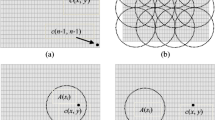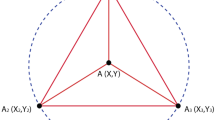Abstract
Wireless sensor networks are often deployed for event detection and environmental monitoring. However, their success in providing quality of service can only be ensured if the network does not have any sensing coverage holes. The existence of sensing coverage holes is unavoidable due to various factors such as environmental disasters, random deployment and hardware failure of the sensor nodes. Therefore, detecting the sensing coverage holes is essential for the successful operation of the network. We present a chord-based hole detection method for identifying the sensing coverage holes; this method is effective in identifying both closed and open holes in the region of interest. Since it is also necessary to heal the sensing coverage holes to improve the quality of service of the sensor network, we also propose a sensing coverage hole healing method, namely, the chord-based hole covering (CBHC) method. The CBHC method provides complete sensing coverage of the network using the minimum number of sensor nodes by minimizing the sensing coverage area overlap. Additionally, our proposed method for sensing coverage hole identification can also identify the boundary of the sensor network. The simulation results demonstrate the satisfactory performances of both the proposed hole identification and hole healing methods in identifying the sensing coverage holes and efficiently covering the sensing coverage holes, respectively.














Similar content being viewed by others
References
Zhou, H., Xia, S., Jin, M., & Wu, H. (2015). Localized and precise boundary detection in 3-D wireless sensor networks. IEEE/ACM Transactions on Networking,23(6), 1742–1754. https://doi.org/10.1109/TNET.2014.2344663.
Li, F., Zhang, B., & Zheng, J. (2011). Geographic hole-bypassing forwarding protocol for wireless sensor networks. IET Communications,5(6), 737–744. https://doi.org/10.1049/iet-com.2010.0266.
Li, W., & Wu, Y. (2016). Tree-based coverage hole detection and healing method in wireless sensor networks. Computer Networks,103(C), 33–43. https://doi.org/10.1016/j.comnet.2016.04.005.
Schieferdecker, D. (2015). Location-free detection of network boundaries. ACM Transactions on Sensor Networks,11(4), 1–40. https://doi.org/10.1145/2795232.
Wang, G., Cao, G., & La Porta, T. F. (2006). Movement-assisted sensor deployment. IEEE Transactions on Mobile Computing,5(6), 640–652. https://doi.org/10.1109/tmc.2006.80.
Fang, Q., Gao, J., & Guibas, L. J. (2006). Locating and bypassing holes in sensor networks. Mobile Networks and Applications,11(2), 187–200. https://doi.org/10.1007/s11036-006-4471-y.
Zhang, C., Zhang, Y., & Fang, Y. (2007). Localized algorithms for coverage boundary detection in wireless sensor networks. Wireless Networks,15(1), 3–20. https://doi.org/10.1007/s11276-007-0021-1.
Ghosh, A. (2004). Estimating coverage holes and enhancing coverage in mixed sensor networks. In 29th annual IEEE international conference on local computer networks, Tampa, FL, USA, USA (pp. 68–76). https://doi.org/10.1109/LCN.2004.53.
Ma, H.-C., Kumar Sahoo, P., & Chen, Y.-W. (2011). Computational geometry based distributed coverage hole detection protocol for the wireless sensor networks. Journal of Network and Computer Applications,34(5), 1743–1756. https://doi.org/10.1016/j.jnca.2011.06.007.
Qiu, C., & Shen, H. (2014). A delaunay-based coordinate-free mechanism for full coverage in wireless sensor networks. IEEE Transactions on Parallel and Distributed Systems,25(4), 828–839. https://doi.org/10.1109/TPDS.2013.134.
Li, W., & Zhang, W. (2015). Coverage hole and boundary nodes detection in wireless sensor networks. Journal of Network and Computer Applications,48, 35–43. https://doi.org/10.1016/j.jnca.2014.10.011.
An, W., Qu, N., Shao, F.-M., Xiong, X., & Ci, S. (2016). Coverage hole problem under sensing topology in flat wireless sensor networks. Wireless Communications and Mobile Computing,16(5), 578–589. https://doi.org/10.1002/wcm.2555.
Bejerano, Y. (2012). Coverage verification without location information. IEEE Transactions on Mobile Computing,11(4), 631–643. https://doi.org/10.1109/TMC.2011.85.
Ma, W., Yan, F., Zuo, X., Ren, L., Xia, W., & Shen, L. (2017). Coverage hole detection algorithm without location information in wireless sensor networks. In 2017 3rd IEEE international conference on computer and communications (ICCC) (pp. 357–361). https://doi.org/10.1109/CompComm.2017.8322571.
Zhai, S., Tang, Z., Wang, D., Li, Z., Chen, X., Fang, D., et al. (2017). Coverage Hole Detection and Recovery in Wireless Sensor Networks Based on RSSI-Based Localization. In 2017 IEEE international conference on computational science and engineering (CSE) and IEEE international conference on embedded and ubiquitous computing (EUC), (Vol. 2, pp. 250–257). https://doi.org/10.1109/CSE-EUC.2017.231.
Silva, V. D., Ghrist, R., & Muhammad, A. (2005). Blind swarms for coverage in 2-D. In Proceedings of robotics: science and systems (pp. 335–342).
Yan, F., Vergne, A., Martins, P., & Decreusefond, L. (2015). Homology-based distributed coverage hole detection in wireless sensor networks. IEEE/ACM Transactions on Networking,23(6), 1705–1718. https://doi.org/10.1109/TNET.2014.2338355.
Ghrist, R., & Muhammad, A. (2005). Coverage and hole-detection in sensor networks via homology. In IPSN 2005. Fourth international symposium on information processing in sensor networks, 2005 (pp. 254–260). https://doi.org/10.1109/IPSN.2005.1440933.
Tahbaz-Salehi, A., & Jadbabaie, A. (2008). Distributed coverage verification in sensor networks without location information. In 2008 47th IEEE conference on decision and control (pp. 4170–4176). https://doi.org/10.1109/CDC.2008.4738751.
Dłotko, P., Ghrist, R., Juda, M., & Mrozek, M. (2012). Distributed computation of coverage in sensor networks by homological methods. Applicable Algebra in Engineering, Communication and Computing,23(1), 29–58. https://doi.org/10.1007/s00200-012-0167-7.
Fekete, S. P., Kröller, A., Pfisterer, D., Fischer, S., & Buschmann, C. (2004). Neighborhood-Based Topology Recognition in Sensor Networks. In Algorithmic Aspects of Wireless Sensor Networks (pp. 123–136). Berlin: Springer. https://doi.org/10.1007/978-3-540-27820-7_12.
P. Fekete, S., Kaufmann, M., Kröller, A., & Zweig, K. (2005). A new approach for boundary recognition in geometric sensor networks. In Canadian conference on computational geometry (pp. 84–87).
Funke, S., & Klein, C. (2006). Hole detection or: “how much geometry hides in connectivity?”. In Proceedings of the twenty-second annual symposium on Computational geometry—SCG ‘06, Sedona, Arizona, USA (pp. 377–385). ACM. https://doi.org/10.1145/1137856.1137911.
Senouci, M. R., Mellouk, A., & Assnoune, K. (2014). Localized movement-assisted sensordeployment algorithm for holedetection and healing. IEEE Transactions on Parallel and Distributed Systems,25(5), 1267–1277. https://doi.org/10.1109/TPDS.2013.137.
Kang, H., Dong, Y., Yan, F., Xia, W., & Shen, L. (2017). A homology and AOA based hole healing strategy in wireless sensor networks. In 2017 3rd IEEE international conference on computer and communications (ICCC) (pp. 336–341). https://doi.org/10.1109/CompComm.2017.8322567.
Guo, J., & Jafarkhani, H. (2018). Movement-Efficient Sensor Deployment in Wireless Sensor Networks. In 2018 IEEE international conference on communications (ICC) (pp. 1–6). https://doi.org/10.1109/ICC.2018.8422124.
Abolhasan, M., Maali, Y., Rafiei, A., & Ni, W. (2016). Distributed hybrid coverage hole recovery in wireless sensor networks. IEEE Sensors Journal,16(23), 8640–8648. https://doi.org/10.1109/JSEN.2016.2613539.
Qiu, C., Shen, H., & Chen, K. (2015). An Energy-Efficient and Distributed Cooperation Mechanism for k-Coverage Hole Detection and Healing in WSNs. In 2015 IEEE 12th international conference on mobile ad hoc and sensor systems (pp. 73–81). https://doi.org/10.1109/MASS.2015.115.
Chun-Hsien, W., Kuo-Chuan, L., & Yeh-Ching, C. (2006). A Delaunay triangulation based method for wireless sensor network deployment. In 12th international conference on parallel and distributed systems—(ICPADS’06), (Vol. 1, pp. 8). https://doi.org/10.1109/ICPADS.2006.11.
Sahoo, P. K., & Liao, W. (2015). HORA: A distributed coverage hole repair algorithm for wireless sensor networks. IEEE Transactions on Mobile Computing,14(7), 1397–1410. https://doi.org/10.1109/TMC.2014.2359651.
Kang, Z., Yu, H., & Xiong, Q. (2013). Detection and recovery of coverage holes in wireless sensor networks. Journal of Networks,8(4), 822–828.
Aliouane, L., & Benchaiba, M. (2014). HACH: Healing Algorithm of Coverage Hole in a Wireless Sensor Network. In 2014 Eighth international conference on next generation mobile apps, services and technologies (pp. 215–220). https://doi.org/10.1109/NGMAST.2014.35.
Paton, K. (1969). An algorithm for finding a fundamental set of cycles of a graph. Communications of the ACM,12(9), 514–518. https://doi.org/10.1145/363219.363232.
Žalik, B. (2000). Two efficient algorithms for determining intersection points between simple polygons. Computers & Geosciences,26(2), 137–151. https://doi.org/10.1016/S0098-3004(99)00071-0.
Hormann, K., & Agathos, A. (2001). The point in polygon problem for arbitrary polygons. Computational Geometry,20(3), 131–144. https://doi.org/10.1016/S0925-7721(01)00012-8.
Tomita, E., Tanaka, A., & Takahashi, H. (2006). The worst-case time complexity for generating all maximal cliques and computational experiments. Theoretical Computer Science,363(1), 28–42. https://doi.org/10.1016/j.tcs.2006.06.015.
de Berg, M., van Kreveld, M., Overmars, M., & Schwarzkopf, O. (1997). Linear programming. In Computational geometry: algorithms and applications (pp. 63–92). Berlin: Springer.
Wang, Y., Gao, J., & Mitchell, J. S. B. (2006). Boundary recognition in sensor networks by topological methods. In Proceedings of the 12th annual international conference on Mobile computing and networking, Los Angeles, CA, USA (pp. 122–133). ACM. https://doi.org/10.1145/1161089.1161104.
Author information
Authors and Affiliations
Corresponding author
Additional information
Publisher's Note
Springer Nature remains neutral with regard to jurisdictional claims in published maps and institutional affiliations.
Rights and permissions
About this article
Cite this article
Singh, P., Chen, YC. Sensing coverage hole identification and coverage hole healing methods for wireless sensor networks. Wireless Netw 26, 2223–2239 (2020). https://doi.org/10.1007/s11276-019-02067-7
Published:
Issue Date:
DOI: https://doi.org/10.1007/s11276-019-02067-7




